
Barbados Provisioning Locations Menu: 1 2 <<First
Golden Age of Piracy Provisioning - Barbados Page 2
Barbados Provisioning History
Although the first Englishmen didn't think much of the prospects for Barbados,
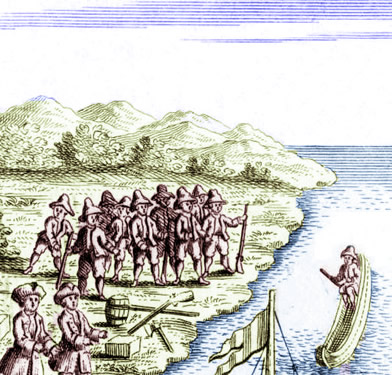
Artist: Franz Urban Bawier
Men Landing on an Island in the Caribbean (1752)
the Dutchmen who landed around 1624 apparently did. As already explained in the previous section, one of "their crews, having procured some refreshments at Barbadoes, and finding the soil capable of cultivation, were induced, on their return to Europe, to speak of it in the most favourable terms."1 The sailors on one of William Courten's ships forced to stop there the next year, "having explored the country, were pleased with the bloom and verdure which every where met their view; and having procured some provisions, probably part of the hogs formerly left here by the Portuguese"2. Arriving back home, historian John Poyer says they described "the beauty and fertility of the island, and of its advantageous position for diffusing the commodities and manufactures of Europe among the rising colonies in the Caribbean Sea"3, which encouraged Courten to send the first settlers to Barbados in 1627. However, Richard Ligon, who lived there between 1647 and 1650, explains in his account of the island's history that Courten's men found Barbados "so overgrown with Wood, as there could be found no Champions, or Savannas for men to dwell in; nor found they any beasts to inhabit there, only Hogs, and those in abundance". Yet he also says that "the fruits and roots that grew there, afforded them [the hogs] so great plenty of food, as they multiplyed abundantly."4
Authors discussing the first European landings on Barbados who mention the food found there all talk about the swine.
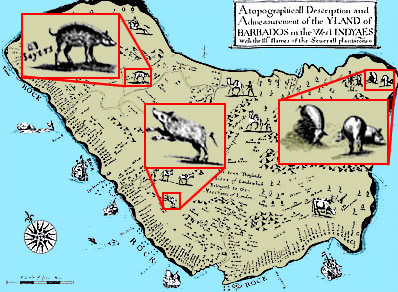
Artist: Richard Ligon
Swine on Barbados, From The Yland of Barbados, (1657)
It is usually felt that this refers to the European pig (Sus scrofa), which were placed on remote islands by the Spanish and Portuguese in an effort to provide food for anyone who might become stranded there. Yet researchers from Simon Fraser University in British Columbia discovered that not all the pigs on the island were this type. Archeologist Christina Giovas was given the jaw bone of a peccary during a visit to the Barbados Museum and Historical Society in 2014. Peccaries are South American mammals which look like wild pigs, but are not native to the Caribbean. However, "their skeletal remains have been found in prehistoric archaeological deposits on several Antillean islands."5 Carbon dating of the bone Giovas was given showed it dated to 1645-1670. When Ligon wrote about the island, he included a map containing three images of pigs (seen at left), a group of which appear to be farm-raised and two of which are wild and have a hairy appearance. Giovas suggests these are representations of peccaries. "Checking historical and archaeological records, we determined the most likely source of peccary introduction was from Spanish or Portuguese ships passing the island in the 16th century—and most likely left as a source of meat for future visiting sailors”.6
When Courten's settlers arrived, they found the provisions lacking according to Ligon.

Artist: Sydney E King
Clearing Land, From Building James Fort in 1607 (20th c.)
This discovery being made, and advice given to their friends in England, other Ships were sent, with men, provisions, and working tools, to cut down the Woods, and clear the ground, so as they might plant provisions to keep them alive, which, till then, they found but straglingly amongst the Woods. But having clear'd some part of it, they planted Potatoes, Plantines, and Mayes [Maiz - corn], with some other fruits; which, with the Hogs-flesh they found, serv'd only to keep life and soul together. And their supplies from England coming so slow, and so uncertainly, they were often driven to great extremities.7
It seems odd that with food from all these different food groups available that the original settlers were 'driven to great extremities.' John Poyer explains, "Potatoes, plantains, and Indian corn were little suited to European habits of living; and ... the distresses of the early colonists were proportionably grievous and oppressive."8 Poyer also says that the amount and quality of the produce was inadequate, which seems a little more supportive of the idea that the colonists experienced such difficulties. Still they continued to clear land and plant. In his review of the history of the island, surgeon John Atkins says that during his visit in 1722 they "planted to little purpose until 1627; since which, the Crops have been so advantageous, as to have raised the Price of the Ground thirty fold."9 Barbados was well-suited for growing; one source explains that the soil in the 17th century "was incredibly fertile; and the facility of obtaining lands and plantations upon the island, had encreased its population to the amazing numbers"10.
The focus of growing food on Barbados when Ligon was there was moving towards sugar which
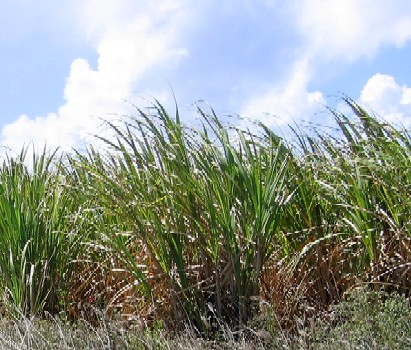
Photo: Wiki User postdlf
Sugar Cane Field in Saint Lucia, Barbados
could be sold to visiting ships for transport to the American colonies and England. Ligon says that on the plantation where he stayed on Barbados consisted
of 500 acres of land, [in which] there was imployed for sugar somewhat more than 200 acres; above 86 acres for pasture, 120 for wood, 32 for Tobacco, 5 for Ginger, as many for Cottonwool, and 70 acres for provisions; viz. Corn, Potatoes, Plantines, Cassavie [cassava], and Bonavist [hyacinth bean]; some few acres of which for fruit 3 viz. Pines [pineapples], Plantines, Milions [melons, probably musk melons], Bonanoes, Guavers, Water Milions, Oranges Limon Limes, &c. most of these onely for the table.11
He also says, "About a hundred sail of Ships yearly visit this Island, and receive, during the time of their stay in the Harbours, for their sustenance, the native Victuals growing in the Island, such as I have already named"12. So the plantation owners saw fit to sell what they didn't grow 'for table' to visiting merchant ships. The navy also made use of the island in the mid-17th century. Historian J. D. Davies notes that although Barbados was "the first port of call for vessels following the normal route from England via the Madeiras, lack of a good harbour precluded establishment of a naval base. However, the navy used the island as a watering point, for purchasing food and restocking ordnance supplies."13
 Artist: Samuel Copen - A Prospect of Bridge Town in Barbados (1695) |
Yet not all of their food seems to have come from the land. As mentioned, Barbados still relied on the colonies in America for supplies. Following a series of national disasters in the mid-late 17th century, they had difficulty getting enough imported food to support themselves. Atkins said in 1722,
The way of feeding such a Multitude [of inhabitants], and providing Necessaries in an Island yielding little besides Sugar, is principally by their Fisheries and Importations. ...Their Importations by Ships from England; Ireland, New-England, Pensylvania, Carolina, or New-York, constantly supplying any Defect of Food or Necessaries, every Vessel bringing them something or other of this kind, which the Merchants keep in store and sell the Planters occasionally"14
He goes on to list some of the things imported for the use of the Barbadians, among which are bisket (biscuit, today called hard tack) at 17 shillings per hundred and salt beef and pork at 40 shillings per 200 weight cask.15 Some of this was likely for provisioning ships, something Barbados was required to do. However, the better class of English settlers also appear to have had a preference to the salt victuals of sailors when they could get it.
1 John Poyer, The History of Barbados, 1808, p. 5; 2,3 Poyer, p. 6; 4 Richard Ligon, A True And Exact History Of the Island of Barbadoes, 1673, p. 23; 5 Christina M. Giovas, George D. Kamenov & John Krigbaum, "87Sr/86Sr and 14C evidence for peccary (Tayassuidae) introduction challenges accepted historical interpretation of the 1657 Ligon map of Barbados", journals.plos.org, gathered 3/2/20; 6 "SFU News: True identity of imposter 'pigs' on 17th century map overturns early colonial history of Barbados", www.sfu.ca, gathered 3/2/20; 7 Ligon, p. 24; 8 Poyer, p. 17; 9 John Atkins, A Voyage to Guinea and Brazil, 1735, p. 205; 10 "The History of Barbados", The Modern Part of An Universal History, 1764, p. 144; 11 Ligon, p. 22; 12 Ligon, p. 40; 13 J. D. Davies, Pepys's Navy, 2008, p. 251; 14 Atkins, p. 208; 15 Atkins, p. 208
Barbados Food Descriptions
“This Isle is exceeding Fertile, bearing Crops all the year long, and its Trees being always cloathed in their Summer Livery, and the Fields and Woods in their Verdure, renders it very delightful to the Inhabitants.” (Richard Blome, A Description of the Island of Jamaica; With Other Isles and Territories in America, 1672, p. 67-8)
There are a variety of descriptions
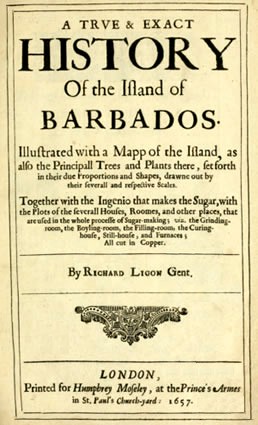
Richard Ligon's A History of Barbados (1657)
of the food growing on Barbados, although their presence here does not indicate that each of these foods were gathered by or sold to visiting ships. The majority of the information here comes from two sources: Richard Ligon's 1673 book, A True And Exact History Of the Island of Barbadoes (first printed in 1657) detailing his time living on Barbados in 1647-50 and Richard Blome's 1672 book A Description of the Island of Jamaica; With Other Isles and Territories in America, which were gathered from "several Papers relating to the Affairs and Description of the other Isles and Territories in America, wherein the English are concerned, which I received from the hands of several of my Friends who are related thereunto"1.
1 Richard Blome, 'The Preface to the Reader', A Description of the Island of Jamaica; With Other Isles and Territories in America, 1672, not paginated
Fruit
A large variety of fruit was grown on Barbados. Blome provides the most extensive list:
Dates, Orenges of two forts, the one sweet, and the other sharp, Pomgranates, Citrons, Limes, Lemons, Macows [probably jackalberries, Diospyros mespiliformis], Grapes, Juneper-Apples, Papayers, Momins [possibly Melicoccus bijugatus], Monbains [Spondias mombin], Acajous [cashews], Icacos [coco plum fruit], Cherries, Raysins, Indian Figgs, Cocos, Plantins, Bonanoes, Guavers, Prickle-Apples , Prickle-Pears, Custard-Apples, Millons [musk-melons], both land and water, and Pine-Apples, the rarest Fruit in the Indies.1
Ligon's list (quoted in the previous section as being grown 'mostly for table')
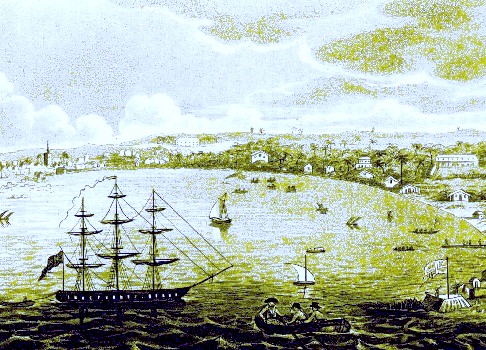
Carlisle Bay and Bridgetown, Barbadoes (1820)
includes pineapples, plantains, musk-melons, bananas, guavas, watermelons, oranges, lemons and limes.2 Except for oranges, these are found in Blome's list. Curiously, Ligon later reports that "Orange trees do not prosper here, nor are the fruits so kindly [probably meaning sweet] as those of Bermudos"3. Although they do not appear in his list, Ligon later lists several of the fruits mentioned in Blome's list later in his text including prickle-apples, prickle pears, custard-apples, pomegranates, cucumbers and grapes.4 Sailor Edward Barlow also provided a list of fruits he found on the island when visiting in 1678. Like Ligon, his list overlaps some of that mentioned by Blome. It includes: "plantains... bananas, lemons, and oranges, guavas, mush-melons and water-melons, cucumber [and] sour grapes"5. (Note that cucumbers are technically considered a fruit, even today.) Barlow's was aboard the merchant vessel Guannaboe, which anchored at Bridgetown to drop off letters as well as take in water and 'a recruit' (probably of food) for passengers. The ship was only there for a day, so his experience probably reflects what was available at that location alone.
Ligon also provides descriptions of the various fruits in his book, some of which are of interest, either for his description, how the fruit was prepared, or both. Of the prickled apple (soursop, the fruit of Annona muricata) he says it "is shap'd like the heart of an Oxe, and much about that bigness; a faint green on the outside,
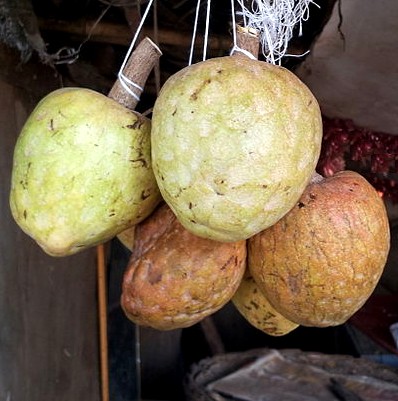
Photo: Akshay Paramatmuni - Custard Apples For Sale By Indian Fruit Vendor
with many prickles on it, the taste very like a mustie Lemon."6 He explains that papaya fruit "we boyl, and serve it up with powdred pork"7. A guavas is "soft, and of a delicate taste; it holds within a pulpy substance, full of small seeds, like a fig, some of them white within, and some of a stammel colour. …These fruits have different tastes, some rank, some sweet"8. Ligon waxes eloquent when explaining how they eat custard apples (Annona reticulata):
We cut a hole at the lesser end, (that it may stand the firmer in the dish) so big, as that a spoon may go in with ease, and with the spoon eat it. Never was excellent Custard more like itself, than this to it; only this addition, which makes it transcend all Custards that art can make, though of natural ingredients; and that is, a fruity taste, which makes it strange and admirable. Many seeds there are in it, but so smooth, as you may put them out of your mouth with some pleasure.9
Of watermelons, Ligon says that he has seen them "as a Cloakbag with a suit of cloaths in it… This fruit within is not unlike an Apple for colour; but for taste, not like any fruit I know in England, waterish, and wallowish; yet the people there eat strange quantities of it, two or three pieces, big, as if cut round, about a twelve-penny loafe an inch thick."10 He notes that bananas are sweeter than plantains and

Pineapple, From Nurembergische Hesperides, By Johann
Christoph
Volker (1708-14)
"we find them as good to stew, or preserve, as the Plantine, and will look and taste more like Quince."11
He saves the pineapple for his most lavish description, stating that the scent of the ripe fruit "is as far beyond the smell of our choicest fruits of Europe, as the taste is beyond theirs." To eat it,
first cut off the crown, and send that out to be planted; and then with a knife, pare off the rinde… we lay the fruit in a dish, and cut it in slices, half an inch thick; and as the knife goes in, there issues out of the pores of the fruit, a liquor, cleer as Rock-water, neer about six spoonfulls, which is eaten whith a spoon; and as you taste it, you find it in a high degree delicious, but so milde, as you can distinguish no taste at all; but when you bite a piece of the fruit, it is so violently sharp as you would think it would fetch all the skin off your mouth; but, before your tongue have made a second trial upon our palat, you shall perceive such a sweetness to follow, as perfectly to cure that vigorous sharp and between these two extreames, of sharp and sweet, lies the relish and flavor of all fruits that are excellent… This fruit within, is neer of the colour of an Abricot not full ripe, and eates crispe and short as that does; but it is full of pores, and those of such formes and colours, as 'tis a very beautiful sight to look on, and invites the appetite beyond measure. Of this fruit you may eat plentifully, without any danger of surfeting [becoming sick to your stomach].12
1 Richard Blome, A Description of the Island of Jamaica; With Other Isles and Territories in America, 1672, p. 73-4; 2 Richard Ligon, A True And Exact History Of the Island of Barbadoes, 1673, p. 22; 3 Ligon, p. 69; 4 See Ligon, pp. 69-72 & 80-83; 5 Edward Barlow, Barlow’s Journal of his Life at Sea in King’s Ships, East and West Indiamen & Other Merchantman From 1659 to 1703, p. 312; 6 Ligon, p. 70; 7 Ligon, p. 71; 8 Ligon, p. 71-2; 9 Ligon, p. 72; 10 Ligon, p. 80; 11 Ligon, p. 82; 12 Ligon, p. 83
Vegetables
The authors have less to say about vegetables on Barbados and they lump them in with herbs. Blome again gives a nice list:
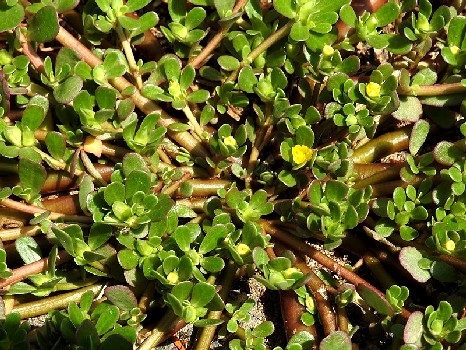
Photo: Robert Flogaus-Faust - Purslane (Portulaca oleracea)
"divers sorts of English hearbs, and roots, as Rosemary, Lavender, Lavender-Cotton, Marjerom, Winter-Savory, Time, Parsley, Tansey, Sage, Purcelane, &c. and for Roots, Cabages, Colworths, Collyflowers, Turnips, Potatoes, Onions, Garlick, Radishes, Lettice, Taragon, Marigolds, &c."1 (Apparently the leaves of Marigolds are eaten.) Ligon mentions the vegetables grown on the plantation where he was staying which included corn, potatoes and hyacinth beans.2 Later in his text, he talks about two kinds of red peppers, "both so violently strong, as when we break the skin, it sends out such a vapour into our Lungs, as we fall all a Coughing"3. He says that the Spanish use them, suggesting that the English do not. Like Blome, he later lists a variety of English herbs and roots, beginning by noting, "I know no herbs naturally growing in the Island, that have not been brought thither from other parts, but Purcelane; and that growes so universally, as the over-much plenty makes it disesteemed ; and we destroy it as a Weed that cumbers the ground." He goes on to list the introduced species that are more valued, including:
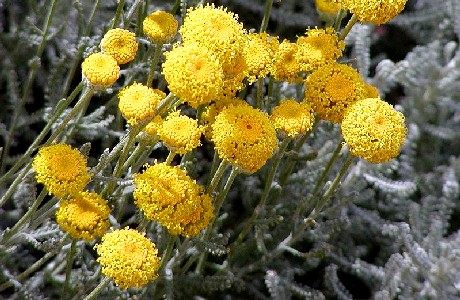
Photo: Stan Shebs - Lavender Cotton (Santolina chamaecyparissus)
Rosemary, Time, Winter-savory, sweet Marjerom, pot Marjerom, Parsley, Penniroyal, Camomile, Sage, Tansie, Lavender, Lavender Cotten [Santolina chamaecyparissus], Garlick, Onyons, Colworts, Cabbage, Turnips, Redishes, Marigolds, Lettice, Taragon, Southernwood [Artemisia abrotanum]. All these I carried with me in seeds, and all grew and prospered well. Leek-Seed I had, which appeared to me very fresh and good; but it never came up.4
There is a lot of overlap with Blome, perhaps suggesting some of Blome's list came from Ligon's book since Ligon says he planted the things he listed. Independent of these two sources are the couple of vegetables mentioned by Barlow during the day he spent at Bridgetown: "potatoes, and yams... very good herbs and ‘salleting [salading]".5
1 Richard Blome, A Description of the Island of Jamaica; With Other Isles and Territories in America, 1672, p. 75; 2 Richard Ligon, A True And Exact History Of the Island of Barbadoes, 1673, p. 22; 3 Ligon, p. 79; 4 Ligon, p. 99; 5 Edward Barlow, Barlow’s Journal of his Life at Sea in King’s Ships, East and West Indiamen & Other Merchantman From 1659 to 1703, p. 312
Bread and Grains
Richard Ligon is the only contemporary author under study to talk about bread and grains on Barbados in any detail. He begins by complaining about the lack of proper (English) bread, but goes on in detail a couple of substitutes. The first is made from cassava root, the processing of which he explains in fairly succinct detail:
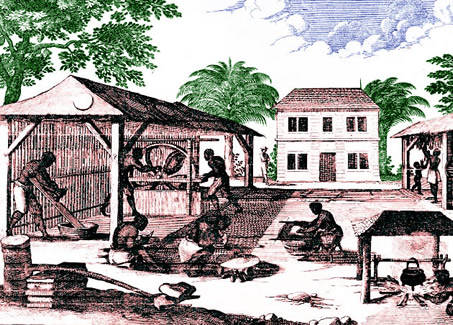
Artist: Jean Baptiste Du Tetre
The Various Steps to Processing Cassava Root to Make Flour,
From Histoire generale
des Antilles (1667)
"They wash the outside of the root clean, and lean it
against a Wheel, whose sole is about a foot broad, and covered with Lattin [lead], made rough like a large Grater. The Wheel [is] to be turned... as it grates the root, it falls down in a large Trough, which is the receiver appointed for that purpose. This root thus grated, is ... put into a strong piece of double Canvas, or Sackcloth, and press'd hard, that all the juice be squeezed out, and then opened upon a cloath, and dryed in the Sun, 'tis ready to make bread. And thus 'tis done."1
From there it is cooked by being put on an iron about twenty inches in diameter where "it will presently stick together... they [the natives] so turn and re-turn it so often till it be flat enough"2. The resulting bread is "as thin as a wafer, and yet purely white and crisp, as a new made wafer."3 Ligon thought the best sort of this tasted like almonds when eaten in milk. Cassava bread was a staple throughout Asia, Africa, the Caribbean and South America.
Ligon also says that cassava could be combined with corn and made "into large Cakes, two inches thick; and that, in my opinion, tastes the likest to English bread of any."4 The third substitute for bread Ligon mentions are potatoes, noting only the the largest and dryest ones are used in this way.
1 Richard Ligon, A True And Exact History Of the Island of Barbadoes, 1673, p. 29; 2,3,4 Ligon, p. 30
Fish
Fish were a staple food on Barbados and Blome mentions quite a variety of them. "Here are great store of Fish in their the Sea, as Snappers, Crabs, Lobsters, Terbums [tarpon], Macquerels, Mullots, Cavallos [Crevalle jacks], Parrot-Fish, Cony-Fish [probably red hind - Epinephelus guttatus], and green Turtles, which of all others
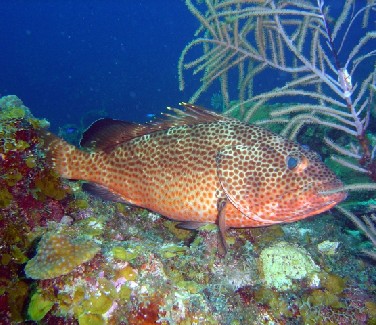
Photo: Fernando Herranz Martin - Red Hind (Epinephelus guttatus)
are the most delicious, with several other sorts appropriated to this and the rest of the Caribbee Isles. But the Rivulets, or Ponds, have few or no Fish in them."1
Ligon notes that the owner of the plantation where stayed took a variety of fish in his sain [net] including "Snappers, red and grey, Cavallos, Macquerels, Mullets, Cony-fish, with divers others, firm and excellent sweet fish"2. He later adds crabs to his list, noting that he did so "because this kind of them live upon the land... they are small Crabs, such as women sell by dozens in baskets in the streets, and of that colour raw and alive, as these are boyſ'd, which are of a reddish."3 However, he doesn't consider them to be good food.
Navy surgeon John Atkins also mentions several fish caught by Barbadians, including "great plenty of flying Fish, Dolphins, Barricuda and King Fish [king mackerel], particularly the first; they bait with their own Specie, which thrown about, the Fish fly in such numbers to the Boats, that they take them up with Dip-nets, and sometimes the Dolphins with them; the Season goes off at the Autumnal Equinox."4
1 Richard Blome, A Description of the Island of Jamaica; With Other Isles and Territories in America, 1672, p. 73-4; 2 Richard Ligon, A True And Exact History Of the Island of Barbadoes, 1673, p. 36; 3 Ligon, p. 65-6; 4 John Atkins, A Voyage to Guinea and Brazil, 1735, p. 208-9
Meat
For land-bound animal meat, the swine brought to the island in the 16th century were the earliest example and their genesis has already been discussed. Blome points out that there "are no Beasts or Cattel but what are Tame, and brought them [there?]; as ...Oxen, Bulls, Cowes, Sheep, and Goats, and Hoggs"1. Ligon discusses several meat animals in his book, although he does not list them in a concise manner. However, he mentions hogs, sheep, goats, rabbits and beef, the last of which he calls 'the greatest rarity in the Island'.2 Blome adds that beef and mutton are "very dear, as having but a small stock"3.
Not surprisingly, pork was the staple meat for Barbados. By 1647, Ligon said that the island had
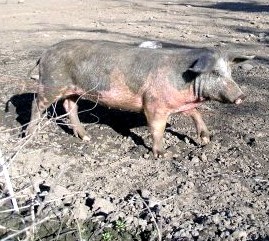
Photo: Hywel Williams - A Pig Going His Way
hogs "in abundance, but not wild or loose, for if they were they would do more harm than their bodies are worth; they are enclos'd, and every man knows his own"4. He felt that penning them up had an unfortunate side-effect, causing "their want of health, which much hindred .their growth; So that they were neither so large,
nor their flesh so sweet, as when they were wild, and at their own liberty, and choice of feeding."5 He convinced the plantation owner where he stayed to increase the size of his pen. As a result, "they wanted very little of their largeness when they were wild. They are the sweetest flesh of that kind, that ever I tasted, and the lovliest to look on in a dish, either boyſ'd, roasted, or bak'd: With a little help of art."6 Blome, who had apparently never been to the island, reported that pork was "their common food, whose Flesh is esteemed very good and delicious"7. Ligon adds an interesting detail, noting that planters "that rear them to sell, do commonly sell them for a groat a pound; weighing them alive; sometimes six pence if flesh be dear."8 He doesn't go so far as to say the meat is sold to visiting ships, however.
Other land-bound meats found on Barbados were less common, including mutton, goat and rabbit. Like Blome, Ligon says they only have a few sheep on Barbados, and they "do not like well the pasture, being very unfit for them". He goes on to say that the sheep brought from England often become diseased and are never fat, with the meat having "a very faint taste, so that I do not think they are fit to be bred or kept in that Countrey"9 He suggests that the 'long-haired' sheep from Guinea-Bissau are fitter for the island, but more "like Goats than Sheep, yet their flesh is tasted more like Mutton than the other."10 He adds that there are far more goats than sheep on the island and they often live in the woods, stating that they taste the same as goats found elsewhere. Last are the rabbits, which Ligon says taste like chicken.11 (Seriously.)
A variety of fowl also provided meat to the Barbadians. Blome lists "Turkeys, Hens,
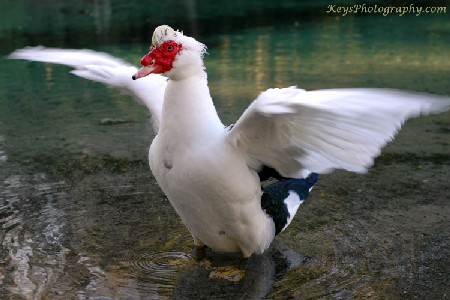
Photo: Steven H Keyes - Domestic Muscovy Duck
Muscovy-ducks, Pigeons, Turtle-Doves, &c. and for small Birds, great variety; as Thrushes, Black-birds, Sparrows, &c."12 Most of these are also mentioned by Ligon, who advises that the turkeys are almost as good as the pork, being "large, fat, and full of gravy. Next to them, Pullen or Dunghill-foul [chickens]: and last of all, Muscovia-Ducks, which being larded with the fat of this Pork, (being seasoned with pepper and salt) are an excellent bak'd-meat. All these, with their Eggs and Chickens, we eat."13 He adds turtle doves and pigeons to his list of edible fowl, explaining that the last "are so fat, and of such excellent tastes... They are good roasted, boyl'd, or bak'd, but best cut in halves, and stewed; to which Cookery, there needs no liquor [liquid], for their own gravy will abundantly serve to stew them."14
1 Richard Blome, A Description of the Island of Jamaica; With Other Isles and Territories in America, 1672, p. 74; 2 Richard Ligon, A True And Exact History Of the Island of Barbadoes, 1673, p. 38 & 59; 3 Blome, p. 74; 4 Ligon, p. 59; 5 Ligon, p. 33; 6 Ligon, p. 34; 7 Blome, p. 74; 8,9,10 Ligon, p. 59; 11 Ligon, p. 35; 12 Blome, p. 75; 13,14 Ligon, p. 35
Imported Food
Many foods were also imported to the island, supporting historian Richard S. Dunn's assertion that the English preferred their own foods. As is his style, Ligon scatters mentions of imported foods throughout his narrative. "The victuals brought from forraign parts are these, Beef which we have from Holland, from Old and New England,
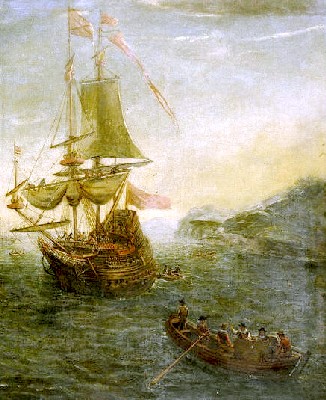
Artist: Gaspar van Eyck - Port scene (17th century)
Virginia, and some from Russia; and yet comes to us sweet. Pork from all these places, with the most sorts of salt fish; as Ling, Haberdine, Cod, poor-John [hake], pickled Macquerels, pickled Herrings, all very good. Sturgeon from New England"1. This list consists entirely of meat. Although pork was abundantly available and apparently very good, it is interesting that 'sweet Pork' was still imported. Ligon later talks about the variety of 'commodities' that merchant bring to Barbados: "Victuals of all kinds, that will endure the Sea, in so long a voyage. Olives, Capers, Anchovies, Salted Flesh and Fish, pickled Macquerels and Herrings, Wine of all sorts, and the boon [English] Beer, d'Angleterre."2
Ligon also discusses several foods he calls 'rarities' which the owner of the plantation where he stayed was able to get via visiting ships 'from any part of the world'. This included "Wine, of all kinds, Oyl, Olives, Capers, Sturgeon, Neats tongues, Anchovies, Caviare, Botargo [Bottarga, salted, cured fish eggs], with all sorts of salted meats, and fish for his Family; as, Beef, Pork, English Pease, Ling, Haberdine, Cod, Poor John, and Jerkin [jerked] Beef, which is husled, and slasht through, hung up and dryed in the Sun; no salt at"3. There is quite a bit of overlap between this and the previous lists. John Atkins mentioned that salt beef and pork were imported along with biscuit (twice-baked bread). He doesn't talk about any of the delicacies Ligon discusses, probably because their ship was only at Bridgetown for six days. It is again worth noting that the majority of the foods mentioned here would likely not have been purchased or eaten by the majority of the sailors.
1 Richard Ligon, A True And Exact History Of the Island of Barbadoes, 1673, p. 37; 2 Ligon, p. 40; 3 Ligon, p. 39

